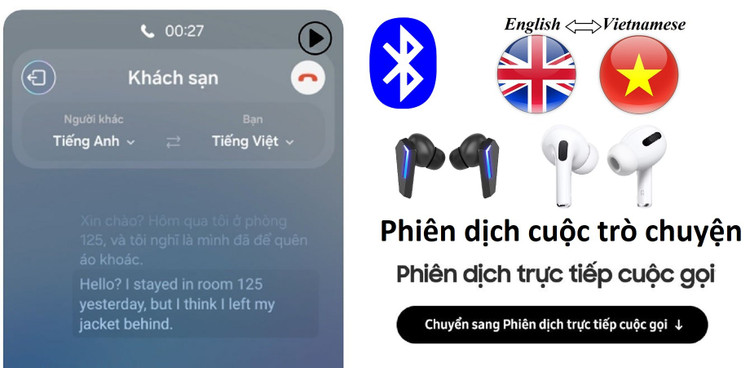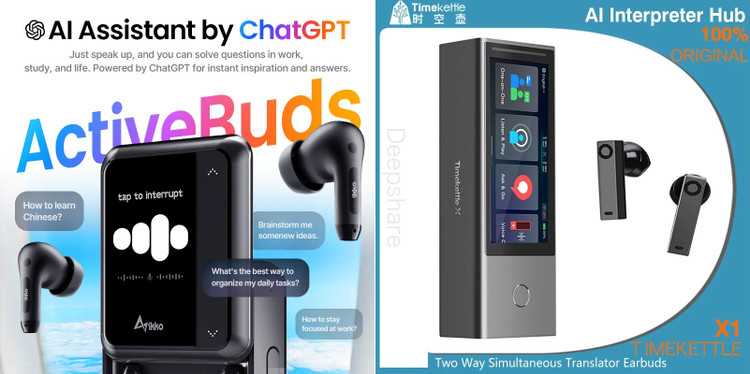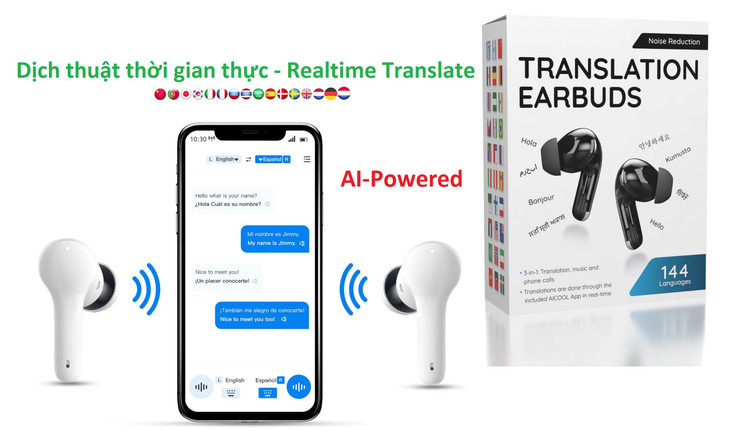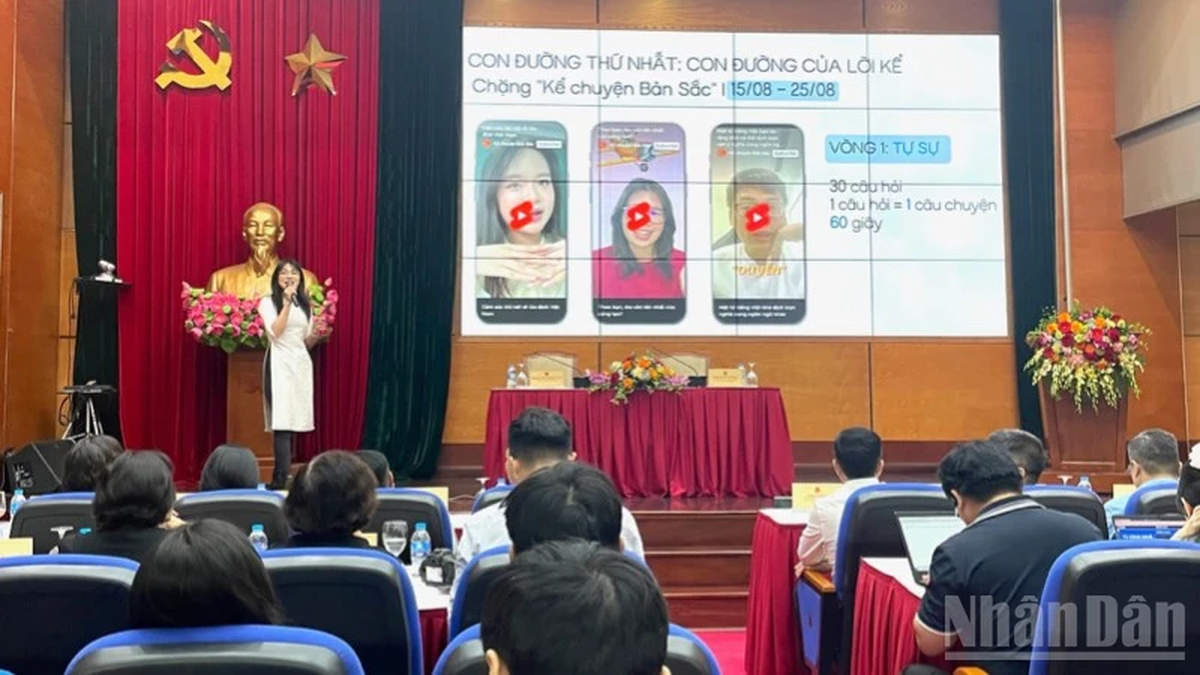In the digital age, language barriers are gradually being eliminated thanks to the explosion of translation technology. In addition to specialized translation machines, AI translation headphones are advertised by brands as a smart device that uses artificial intelligence to translate languages in real time. What makes many people wonder is whether the product quality is commensurate with the brands' advertisements?
Product proliferation
AI translation headphones always need two important factors, which are artificial intelligence and a database to be able to recognize language, process translation and return real-time results via headphones.
Currently, consumers can look to the Timekettle X1 or iKKO ActiveBuds products . Basically, these products are a pair of True Wireless Stereo (TWS) headphones with full functions such as listening to music, talking, active noise cancellation (ANC) and transparency.

The sound quality of this product line is considered quite good, comparable to many wireless headphones in the same price range. The breakthrough lies in the charging box, which is the decisive component that makes it a standalone AI translation headset. The charging box of ActiveBuds and Timekettle X1 has a touch screen, integrated with an independent operating system, can connect to Wi-Fi or insert a 4G SIM.
This allows customers to translate directly on the charging box without the need for a smartphone. The charging box will process the translation, then play the translation through your headphones. The Timekettle X1 can also translate a conference in real time with 5 different languages being used at the same time.
For AI translation headphones that depend on smartphones, users can look to AI headphone solutions from famous technology companies such as Google Pixel Buds, Samsung Galaxy Buds or Timekettle WT2 Plus or Vietnamese brand products such as Vtalk Ear.
Accordingly, Google Pixel Buds Pro2 headphones, possess the strength of the Google Translate platform with more than 40 different languages. Thanks to being developed by Google itself, this headset is rated to have fast and highly accurate translation speed for users.
Meanwhile, Pixel Buds Pro2 integrates AI Gemini, supporting voice operations for users to activate and change translation modes without having to operate the touch button. However, the product has the disadvantage of needing to be connected to a Google Pixel smartphone to use.
Similarly, the Samsung Galaxy Buds 3Pro with Galaxy AI integrated with the Interpreter platform is not far behind. However, it only supports translation when working with Samsung smartphones and the number of languages depends on each different smartphone model.
Timekettle is famous for its WT2 product, which integrates specially tuned AI ChatGPT that can translate more than 40 languages with more than 90 different voices. This is one of the most popular translation headset brands. Although it still requires an application on the phone, this product is famous for its accurate AI voice recognition technology and many translation modes such as Touch Mode (touch to speak) or Speaker Mode (translate via phone speaker), helping users communicate more naturally in different situations. WT2 offers Plus and Edge versions for different ear-wearing styles with prices starting at 4.5 million VND.
Tour guide Vu Mai Huyen shared: “Previously, because I was not really confident in my foreign language ability, I bought a handheld translator. Although the translation ability was quite good, having to carry an additional device was very annoying. When the AI translator headset was sold, I experienced it and chose it right away, it was quite convenient.”
For Vietnamese branded products, users can look to Vtalk AI Ear. As a domestic brand, this product is optimized for Vietnamese language processing (to other languages), ensuring that translations are always clear and in context. This product also has a relatively low price, sold officially for about 1.9 million VND.
“High price” barrier
The biggest barrier when customers decide to choose AI translation headphones is the high price. Users in Vietnam need to spend more than 9 million VND for iKKO ActiveBuds, even Timekettle X1 costs twice as much at 18 million VND. This is really a big barrier even though what it brings in terms of normal headphone and translation functions is not low compared to the price.

In addition, some product lines are limited by only supporting smartphones in the same ecosystem. Mr. Ha Quang, a technical staff of Samsung Hanoi, said: “The biggest disadvantage of the Pixel Buds and Galaxy Buds headphone lines is that they only support smartphones in the same ecosystem. However, that is also why the translation quality is extremely stable. The translation error rate is usually less than 5%”.
In case of using other smartphones, users can choose for themselves multi-platform compatible products. These types are designed with their own AI applications to control and translate on many different platforms regardless of Android or iOS smartphones.
Mostly still dependent on headphones
Engineer Tran Minh Nghia - Equipment consultant atFPT shop commented: "According to the above definition, there are currently very few headphones on the market that have enough platforms to be called translation headphones. These devices are very expensive, the rest, even though they are attached with the word "translation", these products still need another device with enough hardware power to handle the translation, specifically here, a smartphone".

Therefore, according to engineer Tran Minh Nghia: “Most of the products advertised at launch as translation headphones are actually dependent translation headphones, Connected Earbuds. However, it must be affirmed that headphones with integrated AI for translation support are much better and completely different from using a translation application on a smartphone and then playing it through the headphones.”
The most noticeable difference between translation headphones and regular headphones is the ability to automatically translate in real time.
If regular headphones are responsible for transmitting sound from the device to the user's ears, such as when listening to music or making a phone call, then translation headphones are devices equipped with voice recognition capabilities, fast language processing, and integrated AI.
Therefore, translation headphones have the ability to recognize and translate the speech of the other person extremely quickly, supporting a coherent and effective communication process.
As can be seen, for AI translation headphones, the current product lines on the market are clearly different in terms of operating features and prices. Depending on actual needs, users can choose a suitable product for themselves and need to be alert to exaggerated advertisements about their uses.
Source: https://khoahocdoisong.vn/tai-nghe-phien-dich-ai-tro-thu-dac-luc-hay-chieu-tro-quang-cao-post2149045615.html


























![[Photo] Prime Minister Pham Minh Chinh talks on the phone with Cambodian Prime Minister Hun Manet](https://vphoto.vietnam.vn/thumb/1200x675/vietnam/resource/IMAGE/2025/8/15/72d3838db8154bafabdadc0a5165677f)
![[Photo] Prime Minister Pham Minh Chinh attends a special art program called "Hanoi - From the historic autumn of 1945"](https://vphoto.vietnam.vn/thumb/1200x675/vietnam/resource/IMAGE/2025/8/15/c1c42655275c40d1be461fee0fd132f3)
![[Photo] Red and yellow stars at the launching ceremony of the program "Moving Forward with Vietnam"](https://vphoto.vietnam.vn/thumb/1200x675/vietnam/resource/IMAGE/2025/8/16/076df6ed0eb345cfa3d1cd1d7591a66f)

![[Photo] Firmly marching under the military flag: Ready for the big festival](https://vphoto.vietnam.vn/thumb/1200x675/vietnam/resource/IMAGE/2025/8/15/86df2fb3199343e0b16b178d53f841ec)
![[Photo] The special solidarity relationship between Vietnam and Cuba](https://vphoto.vietnam.vn/thumb/1200x675/vietnam/resource/IMAGE/2025/8/15/5f06c789ab1647c384ccb78b222ad18e)

































































Comment (0)